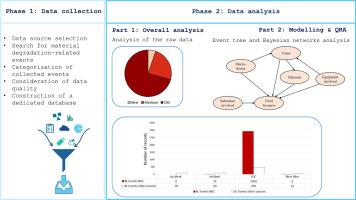材料退化:过程工业历史事故分析的结果
IF 11
1区 工程技术
Q1 ENGINEERING, INDUSTRIAL
引用次数: 0
摘要
在过程工业中,材料降解是风险的一个来源,占密封事故损失的30%。本调查的重点是分析与材料退化有关的历史事件,以提高对过程工业的认识和准备。建立了一个包含3772条记录的数据库。使用工业事故开放访问数据库进行数据收集,根据宏观部门、设备类型、涉及的物质、场景、工厂年龄、事件后采取的行动和损失类型对信息进行分类。腐蚀是主要的失效机制,其次是振动和疲劳。这种现象主要发生在运行超过25年的工厂,在这些工厂中,长期接触化学和环境因素会加速材料的降解。相比之下,较新的工厂更容易因振动而失效。腐蚀事件通常与环境污染事件有关,事件树分析显示,这是最可能发生的情况,在记录的腐蚀事件中,条件概率约为50%。为了完成分析,选择了两个具有代表性的案例研究来应用定量风险评估。在进行第一次频率分析后,利用贝叶斯网络找到了数据库变量之间的条件关系。这种方法允许调查不确定的数据,显示LOC和有毒气体扩散的频率显着上升。对过去事件的分析突出了关键的失效因素,可以考虑采取更有效的预防措施。本文章由计算机程序翻译,如有差异,请以英文原文为准。

Material degradation: Findings from historical accident analysis in process industries
Material degradation represents a source of risk in the process industry, being responsible for 30% of loss of containment events. This investigation focuses on the analysis of historical events related to material degradation to gain awareness and enhance preparedness in the process industry. A database containing 3,772 records was built. Data collection was performed using industrial-accident open access databases, classifying the information according to macro-sector, type of equipment, substance involved, scenario, age of the plant, actions taken after the event and type of losses. Corrosion emerged as the main failure mechanism, followed by vibration and fatigue. This phenomenon occurs predominantly in plants with more than 25 years of operation, where prolonged exposure to chemical and environmental agents accelerates the degradation of materials. In contrast, more recent plants are more prone to failures caused by vibration. Corrosion events were frequently associated with environmental contamination episodes, with Event Tree Analysis showing it as the most likely scenario, representing approximately 50% conditional probability in documented corrosion incidents. To complete the analysis, two representative case studies were chosen for the application of the quantitative risk assessment. Conditional relationships among the variables of the database were found using Bayesian networks after the first frequentist analysis. This method allowed the investigation of uncertain data revealing a notable rise in the frequency of LOC and toxic gas dispersion. The analysis of past events highlighted the critical failure factors, which can be considered for the adoption of more effective preventive measures.
求助全文
通过发布文献求助,成功后即可免费获取论文全文。
去求助
来源期刊

Reliability Engineering & System Safety
管理科学-工程:工业
CiteScore
15.20
自引率
39.50%
发文量
621
审稿时长
67 days
期刊介绍:
Elsevier publishes Reliability Engineering & System Safety in association with the European Safety and Reliability Association and the Safety Engineering and Risk Analysis Division. The international journal is devoted to developing and applying methods to enhance the safety and reliability of complex technological systems, like nuclear power plants, chemical plants, hazardous waste facilities, space systems, offshore and maritime systems, transportation systems, constructed infrastructure, and manufacturing plants. The journal normally publishes only articles that involve the analysis of substantive problems related to the reliability of complex systems or present techniques and/or theoretical results that have a discernable relationship to the solution of such problems. An important aim is to balance academic material and practical applications.
 求助内容:
求助内容: 应助结果提醒方式:
应助结果提醒方式:


